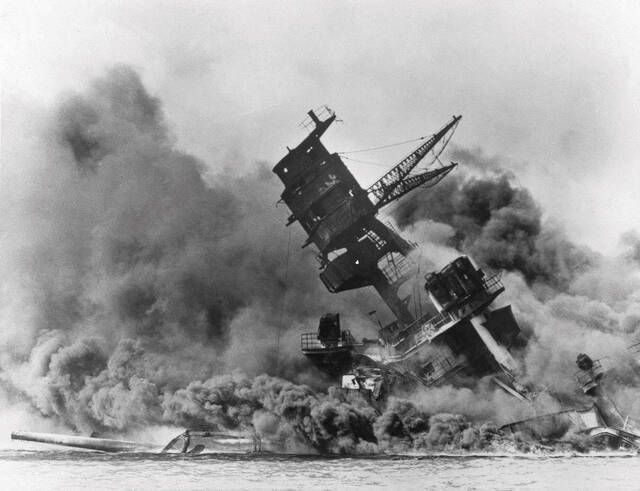
In this Dec. 7, 1941, file photo, smoke rises from the battleship USS Arizona as it sinks during a Japanese surprise attack on Pearl Harbor, Hawaii. (AP file photo)
Click here to subscribe today or Login.
Today marks the 80th anniversary of the 1941 attack on Pearl Harbor that stunned the world and galvanized this nation into mobilizing the most impressive wartime effort in world history.
Unlike any U.S. war waged in later years — or more exactly, unlike any military action, since World War II was the last time the U.S. Congress actually declared war — Pearl Harbor launched a collective sacrifice that can be hard to see happening in these days of partisan self interest.
That opening salvo of bombs and torpedoes by the Japanese killed 2,403 service members and civilians, President Joe Biden noted Friday in a “Proclamation on National Pearl Harbor Remembrance Day, 2021.” The sinking of the USS Arizona, still in harbor, contributed 1,177 to that tally.
“To this day,” Biden said, recalling a past visit to the Pearl Harbor Memorial built on the bones of the venerable battleship’s shallow grave, “beads of oil still rise to the surface of the water — metaphorical ‘Black Tears’ shed for those lost in the attack. Reading those names etched in marble was a mournful reminder of the sacrifices and the human cost of protecting our Nation and the ideals this great country represents.”
The attack spurred a rush to enlist, nationally and locally. Staff Writer Ed Lewis wrote about this in Monday’s Look Back article.
A short story in the Times Leader Evening News on Dec. 9, 1941, was about a man from Trucksville wanting to enlist a day after the Japanese attacked Pearl Harbor, HI.
Like many men after news of the bombing, Albert Williams wanted to join the U.S. Army.
Williams was one of the first men in line at the Army recruiting office at the North Main Street post office in Wilkes-Barre.
“How old are you?” the recruiter asked.
“Forty-four. Married, four children but they’ll manage somehow,” Williams replied.
Williams was beyond the age limit, but he was just one man. As Lewis reported, 140 men appeared at the Army recruiting station in the three days after Pearl Harbor.
Each year this paper and other media outlets searched out survivors who could remember the day, the feeling, and their response. Their numbers constantly diminished, but their examples of bravery, selflessness and sacrifice remain.
By the time the war was over, 300,000 U.S. Service members died in combat and another 100,000 fell in service. Nearly 700,000 more were wounded, many with damage that changed the rest of their lives. In a country with about 132 million people, that assured few were left untouched by tragedy.
But the impact, of course, rippled through nearly every life, even those who had no loved ones in service. People endured rationing, shortages, substitutions. Recycling became not only common sense but a patriotic need. Jobs in manufacturing boomed, rewriting the national economy. The country shamed itself with Japanese internment camps and other over-reactions, and ennobled itself with stunning technological advances, steely resolve and a relentless determination to endure any hardship, fill any need, and end the hidden horror of Hitler’s “Final Solution.”
We need, of course, to remember those who fell this day 80 years ago, and those who sacrificed every day after until the last armistice was signed. But we do well to remember how working together turned back a ruthlessly bloody authoritarian tide.
We could not afford then, nor can we afford now, to fight among ourselves, making enemies of fellow Americans. “Remember Pearl Harbor” isn’t just about our past. It’s about our future.
— Times Leader




